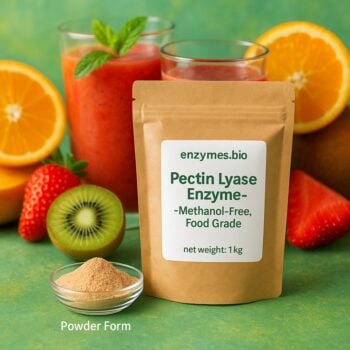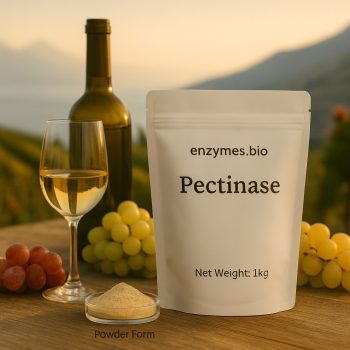Red Wine Enzyme
Enzymes.Bio Wem-007
Formulated For Red Wine
Enzymes.Bio® WEM-007 is developed from an advanced strain through cultivation, fermentation, and extraction techniques, which conform to FCC. It is cultured from Aspergillus niger.
This product is manufactured in accordance with the standards of FDA, WHO, and UECFA.
Main Components: Pectinase, Cellulase, Hemi-cellulase, β-Glucanase, Amylase, and Protease.
Activity of Pectinase: 5,000,000 u/ml.
Product: liquid enzyme in 1 kg / bag (food grade).
Action Principle: In the formulated enzymes, Pectinase is assorted with pectinesterase and depolymerase which decomposes the α-1, 4-galacturonic bond. Endo-pectintranseliminase and Endo-polygalacturonase from the depolymerase are very effective in clarifying grape juice. It reduces the viscosity by decomposing the grape juice pectin.
Cellulase and Hemi-cellulase hydrolyze the polygalacturonic residue in the pectin, and lyse the cell wall; these also help to fully clarify the grape juice and create stability.
Efficacy:
- Fully decomposing the pectin and various sediments in grape juice, and clarifying the grape juice quickly.
- Reduces the viscosity of grape juice to a concentration of 700BX or even higher.
- Speeds up ultra-filtration, and decreases the number of washes of ultra-membrane.
- Effectively prevents the production of turbidity over the stockpile period and therefore stability.
- Enhance the flavor and color of the red wine.
Dosage:
0.01~0.06 L.
Application Method:
Due to the diversity of grape varieties, “picking” timing, and maturities, the winemaker needs to define the dosage according to the actual local conditions. In situations where grapes are not squashy (firm and hard to squeeze), another Enzymes.Bio‘s product – Formulated Enzymes for Fruit Slurry is recommended because it contains more amylum. For fruits which are mature or have been stored for a long time, the polysaccharide may dissociate from the cell wall gradually. The pectin content will also increase so in these cases the dosage should be increased accordingly.
Remarks:
Temperature range: 20~60°C, optimum at 40~50°C.
pH range 3.0~5.5.
Storage:
This product should be transported and stored in a cool and dry place. At 1~10°C, with no sunlight. With these storage conditions, its shelf life is 18 months.




